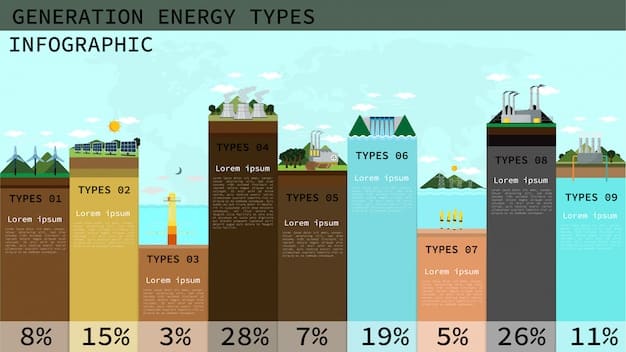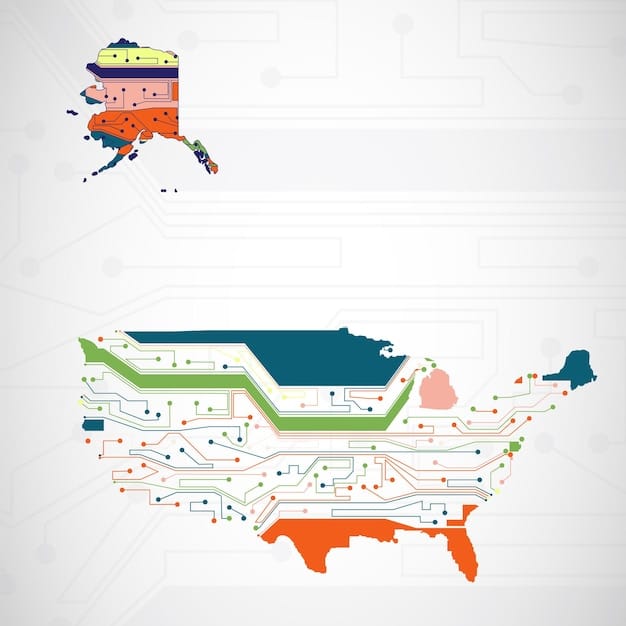How New Energy Policy Shapes Renewable Transition by 2030

New energy policies are crucial in accelerating the transition to renewable energy sources by 2030 by providing financial incentives, setting clear regulatory frameworks, and fostering technological innovation.
The implementation of new energy policies is poised to significantly influence the transition to renewable energy sources by 2030. Understanding these policies and their potential impact is crucial for stakeholders in the energy sector and beyond.
Understanding the Role of Energy Policy
Energy policy plays a vital role in shaping the energy landscape of a nation. It sets the framework for energy production, distribution, and consumption, often with specific goals related to economic growth, energy security, and environmental protection. By understanding the fundamental purposes of energy policy we can better understand its importance.
Key Objectives of Energy Policy
Energy policies are designed to address a range of interconnected objectives, reflecting the complex nature of the energy sector. These objectives often evolve over time in response to changing circumstances, technological advancements, and societal priorities.
- Economic Growth: Energy availability and affordability are essential for economic growth.
- Energy Security: Energy policy aims to ensure a stable and reliable energy supply.
- Environmental Sustainability: Policies are increasingly focused on reducing the environmental impact of energy production.
- Technological Innovation: Energy policies can incentivize research and development of new energy technologies.
Understanding these objectives is key to evaluating the potential impact of new energy policies on the transition to renewable sources.
The Current Energy Policy Landscape in the US
The current energy policy landscape in the United States is a complex patchwork of federal and state regulations, incentives, and programs. It reflects varying priorities, from promoting fossil fuel production to encouraging the growth of renewable energy sectors.

Federal Energy Policies
Federal energy policies are enacted by Congress and implemented by various government agencies. These policies can have a broad impact across the entire nation, influencing energy production, consumption, and trade.
Recent federal energy policies have introduced financial incentives for renewable energy projects, such as tax credits and grants. These incentives aim to make renewable energy more competitive with traditional fossil fuels, encouraging investment and development.
State Energy Policies
State energy policies play a crucial role in shaping the energy mix within individual states. They can complement federal policies or diverge from them, reflecting the unique energy resources, economic priorities, and environmental concerns of each state.
- Renewable Portfolio Standards (RPS): Many states have established RPS, requiring a certain percentage of electricity to come from renewable sources.
- Net Metering Policies: Net metering allows homeowners and businesses with solar panels to receive credit for excess electricity they send back to the grid.
- Energy Efficiency Standards: States often set energy efficiency standards for buildings and appliances to reduce energy consumption.
The interaction between federal and state energy policies can create both opportunities and challenges for the transition to renewable sources by 2030.
How New Policies Can Accelerate Renewable Energy Transition
New energy policies can provide critical incentives and regulatory frameworks to accelerate the shift to renewable sources. These policies address many of the challenges and facilitate the adoption of renewable energy technologies.
Financial Incentives
Financial incentives are powerful tools for promoting renewable energy development. They make renewable energy projects more economically attractive by reducing their upfront costs and improving their long-term profitability.
Tax credits, grants, and loan guarantees are all widely used financial incentives. By lowering the cost of capital, these incentives can encourage private investment and stimulate the growth of the renewable energy industries. These incentives can have a ripple effect.
Regulatory Frameworks
A clear and consistent regulatory framework is essential for creating a stable investment environment. Regulatory frameworks address a wide range of issues, including permitting, grid interconnection, and environmental protection.
- Streamlined Permitting Processes: Streamlined permitting processes reduce the time and cost required to develop renewable energy projects.
- Grid Interconnection Standards: Clear grid interconnection standards ensure that renewable energy projects can connect to the electricity grid efficiently and reliably.
- Carbon Pricing Mechanisms: Carbon pricing mechanisms, such as carbon taxes or cap-and-trade systems, can incentivize the reduction of greenhouse gas emissions.
These frameworks need to be carefully designed to avoid creating unnecessary barriers to renewable energy development.
Potential Challenges and Mitigation Strategies
Despite the potential benefits of new energy policies, there are also potential challenges that need to be addressed. These challenges include economic impacts, technological limitations, and public acceptance.

Economic Impacts
The transition to renewable energy can have significant economic impacts, both positive and negative. While it can create new jobs in the renewable energy sector, it can also lead to job losses in traditional fossil fuel industries.
To mitigate these negative impacts, policymakers can implement job training programs, provide financial assistance to affected communities, and invest in new industries that can create alternative employment opportunities.
Technological Limitations
Renewable energy technologies are constantly improving, but they still face certain limitations. Intermittency, the fact that renewable energy sources like solar and wind are not always available, is a major challenge.
To address this challenge, policymakers can invest in energy storage technologies, such as batteries and pumped hydro storage. Advanced grid management technologies can also help to better integrate renewable sources into the grid.
Case Studies: Successful Renewable Energy Transitions
Several countries and regions have already achieved success in transitioning to renewable energy sources. These case studies provide valuable lessons and insights for other jurisdictions. Studying these successes can lead to further achievements.
Germany’s Energiewende
Germany’s Energiewende, or energy transition, is one of the most ambitious renewable energy programs in the world. Germany has significantly increased its renewable energy capacity through feed-in tariffs and other incentives.
While Germany has faced challenges such as grid integration and higher electricity costs, it has also demonstrated that it is possible to achieve high penetration rates of renewable sources. Their example is one of leadership.
Denmark’s Wind Power Success
Denmark is one of the world leaders in wind power. A significant portion of their electricity comes from wind energy. Denmark has achieved this through strong government support, favorable regulatory frameworks, and a supportive public.
Denmark’s success demonstrates the importance of long-term commitment to renewable energy and the benefits of creating a supportive ecosystem for wind power development. Continued development is expected.
Looking Ahead: Renewable Energy by 2030
The transition to renewable energy sources by 2030 is an ambitious but achievable goal. By implementing effective policies, investing in innovative technologies, and engaging with stakeholders, the United States can accelerate the shift to a cleaner, more sustainable energy future.
Policy Recommendations
To maximize the impact of new energy policies, policymakers should consider the following recommendations.
- Establish Clear and Ambitious Targets: Set clear and ambitious targets for renewable energy deployment.
- Provide Long-Term Policy Support: Provide long-term policy support and stability to encourage investment.
- Invest in Grid Modernization: Invest in grid modernization to accommodate renewable source integration.
- Engage with Stakeholders: Engage with stakeholders, including industry, consumers, and environmental groups.
By embracing these recommendations, the United States can ensure that new energy policies effectively drive the transition to renewable sources by 2030. Success and sustainability are achievable.
| Key Point | Brief Description |
|---|---|
| 💰 Financial Incentives | Tax credits and grants to boost renewable projects. |
| 📜 Regulatory Frameworks | Streamlining permits for renewable energy facilities. |
| 💡 Technological Developments | Investing in energy storage and grid modernization. |
Frequently Asked Questions
▼
The main goals include promoting economic growth through sustainable energy, ensuring energy security, and fostering environmental protection by reducing carbon emissions and promoting cleaner energy sources.
▼
Financial incentives, like tax credits and grants, lower the initial costs and improve the long-term profitability of renewable energy projects, encouraging more private investment and overall growth in the sector.
▼
Regulatory frameworks streamline processes like permitting and grid connections. They also establish standards that guarantee renewable projects are efficiently integrated into the energy grid, promoting a stable and predictable environment.
▼
The shift faces economic challenges, potentially causing job losses in traditional sectors while new sectors emerge. There are also technological limits, such as the intermittency of renewable sources. Lastly, getting public support is another key challenge.
▼
Policymakers can establish ambitious renewable energy targets, provide long-term policy support, invest in modernizing the grid for renewables, and actively engage with stakeholders to create inclusive energy plans that address concerns.
Conclusion
New energy policies are the cornerstone of the transition to renewable energy sources by 2030. Implementing effective policies, addressing potential challenges, and learning from successful case studies can accelerate the shift towards a cleaner and more sustainable energy landscape, ultimately benefiting both the economy and the environment.





